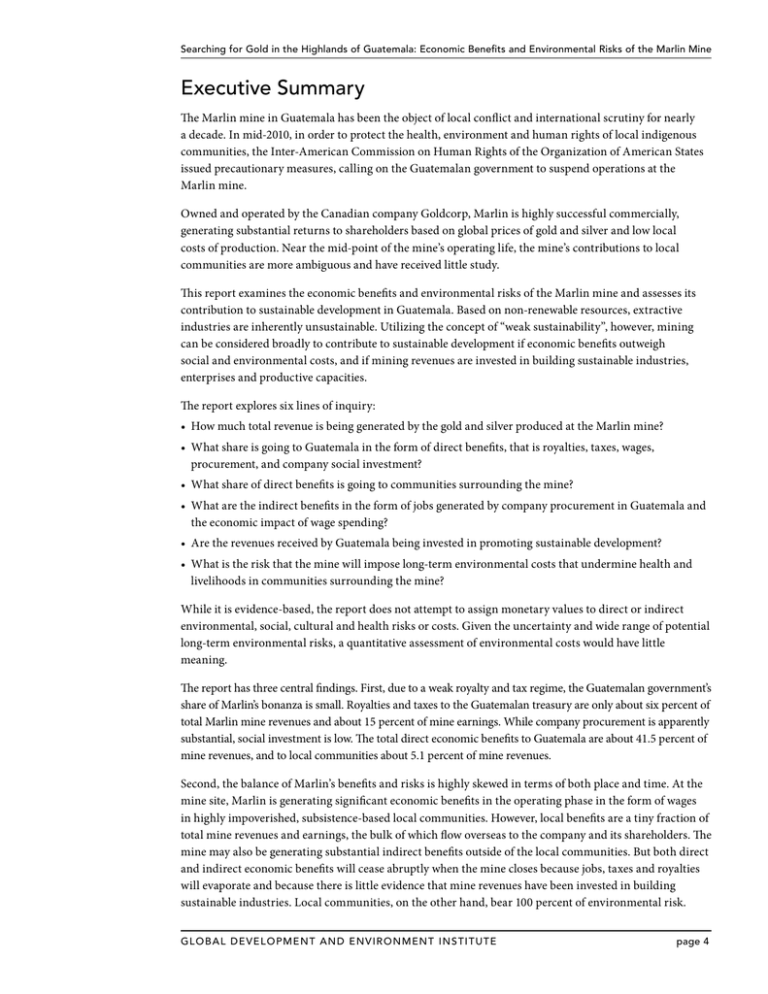Document 10342201
advertisement

Searching for Gold in the Highlands of Guatemala: Economic Benefits and Environmental Risks of the Marlin Mine Executive Summary The Marlin mine in Guatemala has been the object of local conflict and international scrutiny for nearly a decade. In mid-2010, in order to protect the health, environment and human rights of local indigenous communities, the Inter-American Commission on Human Rights of the Organization of American States issued precautionary measures, calling on the Guatemalan government to suspend operations at the Marlin mine. Owned and operated by the Canadian company Goldcorp, Marlin is highly successful commercially, generating substantial returns to shareholders based on global prices of gold and silver and low local costs of production. Near the mid-point of the mine’s operating life, the mine’s contributions to local communities are more ambiguous and have received little study. This report examines the economic benefits and environmental risks of the Marlin mine and assesses its contribution to sustainable development in Guatemala. Based on non-renewable resources, extractive industries are inherently unsustainable. Utilizing the concept of “weak sustainability”, however, mining can be considered broadly to contribute to sustainable development if economic benefits outweigh social and environmental costs, and if mining revenues are invested in building sustainable industries, enterprises and productive capacities. The report explores six lines of inquiry: • How much total revenue is being generated by the gold and silver produced at the Marlin mine? • W hat share is going to Guatemala in the form of direct benefits, that is royalties, taxes, wages, procurement, and company social investment? • W hat share of direct benefits is going to communities surrounding the mine? • W hat are the indirect benefits in the form of jobs generated by company procurement in Guatemala and the economic impact of wage spending? • Are the revenues received by Guatemala being invested in promoting sustainable development? • W hat is the risk that the mine will impose long-term environmental costs that undermine health and livelihoods in communities surrounding the mine? While it is evidence-based, the report does not attempt to assign monetary values to direct or indirect environmental, social, cultural and health risks or costs. Given the uncertainty and wide range of potential long-term environmental risks, a quantitative assessment of environmental costs would have little meaning. The report has three central findings. First, due to a weak royalty and tax regime, the Guatemalan government’s share of Marlin’s bonanza is small. Royalties and taxes to the Guatemalan treasury are only about six percent of total Marlin mine revenues and about 15 percent of mine earnings. While company procurement is apparently substantial, social investment is low. The total direct economic benefits to Guatemala are about 41.5 percent of mine revenues, and to local communities about 5.1 percent of mine revenues. Second, the balance of Marlin’s benefits and risks is highly skewed in terms of both place and time. At the mine site, Marlin is generating significant economic benefits in the operating phase in the form of wages in highly impoverished, subsistence-based local communities. However, local benefits are a tiny fraction of total mine revenues and earnings, the bulk of which flow overseas to the company and its shareholders. The mine may also be generating substantial indirect benefits outside of the local communities. But both direct and indirect economic benefits will cease abruptly when the mine closes because jobs, taxes and royalties will evaporate and because there is little evidence that mine revenues have been invested in building sustainable industries. Local communities, on the other hand, bear 100 percent of environmental risk. G l ob al D e v e l op m e n t a n d E n vi r o n m e n t I n stitute page 4 Searching for Gold in the Highlands of Guatemala: Economic Benefits and Environmental Risks of the Marlin Mine Environmental risk at Marlin is exceptionally high and likely to increase over the remaining life of the mine and into the post-closure phase. Gold mining poses generic hazards related to cyanide and heavy metals contamination of water from acid mine drainage (AMD). In addition to proximity to local communities, environmental risk at Marlin is exacerbated and likely to rise over time due to the lack of adequate environmental regulation and oversight; the absence of an adequate management plan for mine closure; the lack of financial assurance for post-closure remediation and monitoring, and the failure to take projected climate change impacts into account in mine design and post-closure planning. Risk is also heightened by local poverty and dependence on agriculture and the lack of legislative or judicial protection of the rights of indigenous people. Besides the risk to human health, the greatest long-term environmental “... when juxtaposed against the long-term and risk of the mine is that its lasting and widespread water contamination will undermine agricultural livelihoods, uncertain environmental risk, the economic impoverishing local communities. benefits of the mine to Guatemala and especially The third finding of the report is that the Marlin mine is contributing little to sustainable development in Guatemala. While it is the largest single taxpayer in meager and short-lived.” Guatemala, Marlin’s fiscal contribution will terminate when the mine closes. A lack of transparency and accountability suggests that little of the royalty and tax revenue has been invested in public goods such as education, health, and infrastructure that build sustainable productive capacities. A substantial portion of the mine’s procurement of supplies and equipment is sourced within Guatemala, mostly for energy, though very little is sourced locally. However, lack of data precludes an evaluation of the potential development spillovers from local procurement. Finally, company social investment is low and stagnant and there is little evidence that is promoting sustainable enterprise. to local communities under a business-as-usual scenario are Adding all economic benefits together—royalties, taxes, wages, procurement and social investment— Guatemala receives about 42 percent of total mine revenues, substantially below best practice in global mining operations. Local communities receive only about 5 percent of total mine revenues. Overall, the report concludes that, when juxtaposed against the long-term and uncertain environmental risk, the economic benefits of the mine to Guatemala and especially to local communities under a business-as-usual scenario are meager and short-lived. The report makes three recommendations. First, Goldcorp and the Guatemalan government should agree to suspend Marlin operations, as ordered by the Inter-American Commission on Human Rights, until environmental and human rights safeguards are put in place and further information is gathered. The company and the government should collaborate with local stakeholders to: 1) undertake a comprehensive and rigorous environmental and health assessment in the entire watershed surrounding the Marlin mine; 2) undertake an assessment of projected climate change impacts; 3) produce a comprehensive and robust design and implementation plan for mine closure and post-closure monitoring and remediation; and 4) undertake a detailed socio-economic assessment, including indirect jobs, the economic impacts of wage spending, and an account of expenditure of mine royalties and taxes. The assessment should include options for the development of sustainable enterprise and industry in the region, including in agriculture. The government should also suspend operations at Cerro Blanco, Goldcorp’s mine now in development, pending the results of similar investigations. Second, Guatemala’s Mining Law should be reformed to enable the capture for the public purse of a higher share of mining revenue. A reformed Mining Law should also give a substantially larger proportion of royalties to local municipalities. G l ob al D e v e l op m e n t a n d E n vi r o n m e n t I n stitute page 5 Searching for Gold in the Highlands of Guatemala: Economic Benefits and Environmental Risks of the Marlin Mine Third, the capture of greater economic benefits and reduced environmental risk require significant development of Guatemala’s governance capacity in three dimensions: 1) environmental and health regulation and oversight; 2) legislative definition and judicial protection of the rights of indigenous people; and 3) fiscal accountability. Also needed is a sustainable development plan that allocates mine revenues into targeted investments in building sustainable productive capacities, especially in indigenous communities. Without good governance and productive investment, the local legacy of the Marlin mine could well be ecological devastation and impoverishment. I. Introduction I .1 W h y th i s r e p o r t ? Since it was first proposed, the Marlin gold mine in the western highlands of Guatemala has generated intense local conflict and international scrutiny on human rights and environmental grounds. People have been killed and arrested protesting the mine and in locally-run referenda, indigenous communities have rejected mining as a development strategy in general and the Marlin mine in particular. The InterAmerican Commission on Human Rights of the Organization of American States (IACHR) issued precautionary measures, ordering the Guatemalan government to suspend mine operations and to “implement effective measures to prevent environmental contamination” until the Commission decides on the merits of a petition brought by Guatemalan groups (IACHR, 2010, p. 680). Buoyed by a boom in global commodity prices, the Marlin mine is part of a global expansion of investment in extractive industries. For the government of Guatemala, as for other developing countries with mineral resources, the mine represents a source of fiscal revenue, export earnings and high-paying jobs, as well as the opportunity for industrial transformation and economic development. With over half its population living in poverty, Guatemala is among the poorest countries in Latin America. Owned and operated by the Canadian company Goldcorp, the Marlin mine began extractive operations in December 2005 and has an expected life of 10-15 years. Due to the soaring global price of gold and low local costs of production, it has generated substantial returns to shareholders. The mine’s economic contributions to local communities and to sustainable development in Guatemala, however, are ambiguous and have received little study. This report evaluates the economic benefits of the Marlin mine to local communities and to Guatemala’s sustainable development and assesses its environmental risks. It explores six lines of inquiry: • How much total revenue is being generated by the gold and silver produced at the Marlin mine? • W hat share is going to Guatemala in the form of direct benefits, that is royalties, taxes, wages, procurement, and company social investment? • W hat share of direct benefits is going to communities surrounding the mine? • W hat are the indirect benefits in the form of jobs generated by company procurement in Guatemala and the economic impact of wage spending? • Are the revenues received by Guatemala being invested in promoting sustainable development? • W hat is the risk that the mine will impose long-term environmental costs that undermine health and livelihoods in communities surrounding the mine? G l ob al D e v e l op m e n t a n d E n vi r o n m e n t I n stitute page 6








